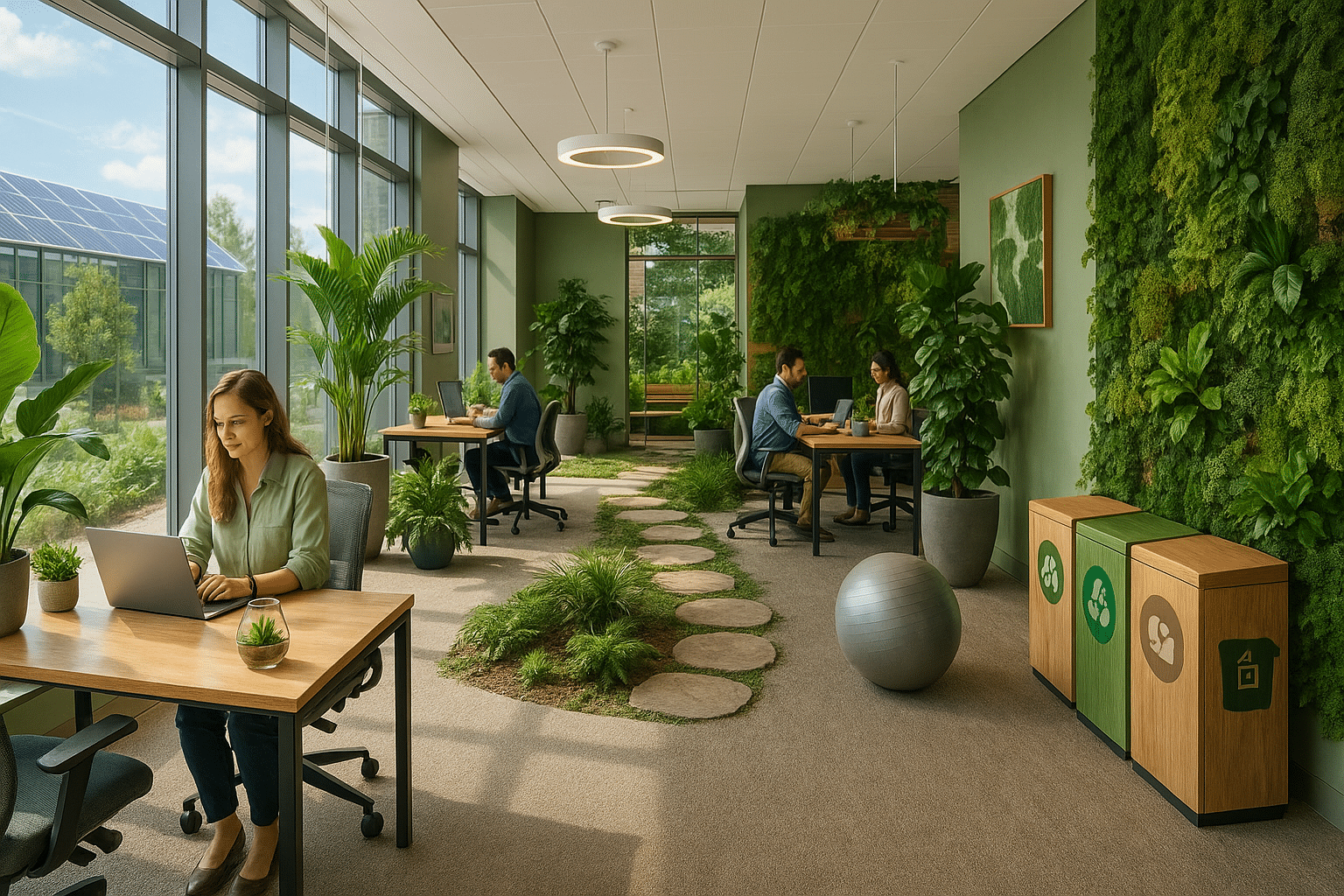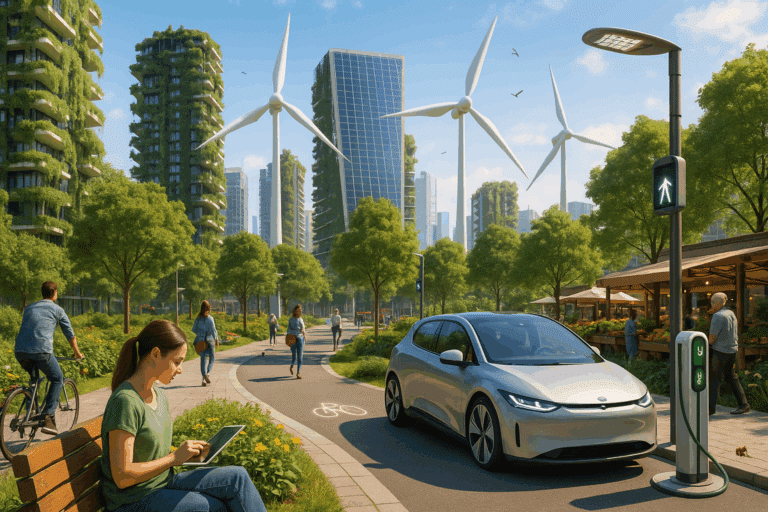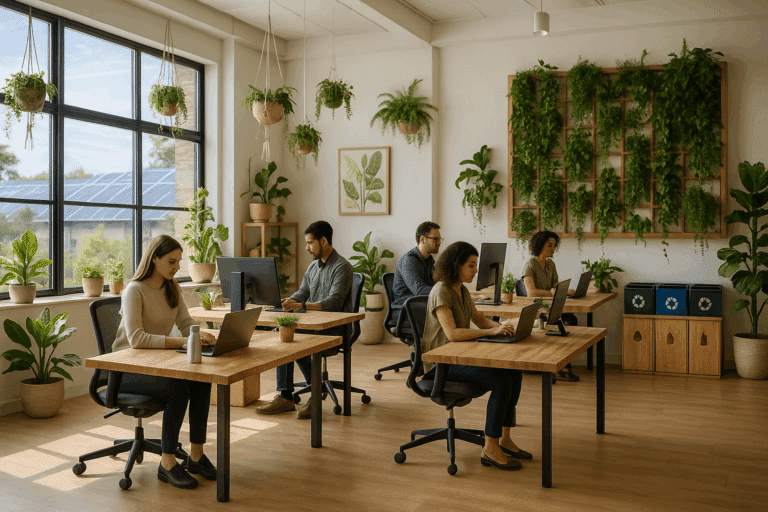🌍 As we peer through the looking glass into the future, one area that demands our immediate attention is facility management. Redesigning and reimagining our buildings to be more environmentally friendly isn’t just a trend; it’s a necessity. If the phrase “Greening Your Space” tickles your curiosity, you’re in the right place! Let’s delve into this engaging journey of Eco-Friendly Facility Management for a Sustainable Future.
Where exactly does facility management come into the picture? 🏢 It’s pretty simple – facilities, ranging from corporate offices to residential buildings, are a significant contributor to environmental degradation. They account for a considerable portion of energy consumption, water use, and greenhouse gas emissions. But the good news is, they also hold the potential for immense change. By infusing sustainability into our facilities, we can not only conserve resources but also create healthier, more productive environments. A win-win situation, if you ask me!
What to Expect from this Article
In this comprehensive guide, we’ll start by unraveling the concept of eco-friendly facility management.🌿 What does it entail? What are its core principles? We’ll then traverse through the various strategies that facility managers can adopt to green their spaces – from energy-efficient designs and renewable energy sources to waste reduction and water conservation methods.
It’s not all technical, though! We’ll also showcase how eco-friendly facility management can boost your bottom line. 💰 Yes, you read that right. Sustainability is not just good for the planet, but also for your pocket! We’ll explore the various financial benefits that come with green practices, along with numerous case studies that illustrate their successful implementation.
And finally, we’ll shine the spotlight on some of the latest trends and technologies in this realm. From smart buildings that leverage AI to optimize energy use, to green certifications that can enhance your brand’s reputation – the future of facility management is as exciting as it is green!
Why You Should Stick Around
If you’re a facility manager looking to minimize your environmental impact, an architect wanting to design more sustainable buildings, or simply a curious mind intrigued by the intersection of technology and sustainability, this article is for you. 🎯 We’ve put together a thorough, well-structured, and detailed guide that will arm you with the knowledge and tools you need to make your facility more eco-friendly.
But don’t worry, we’re not going to drown you in jargon and technicalities. Our goal is to make this topic accessible and understandable, regardless of your background or expertise. With a dash of engaging storytelling and a sprinkle of practical tips, we aim to make your journey towards sustainability as smooth and enjoyable as possible. So, are you ready to embark on this exciting voyage towards a greener future? Let’s get started! 🚀
Unveiling Eco-Friendly Facility Management: A Catalyst for a Sustainable Future
As we witness a growing concern about the environment, eco-friendly facility management emerges as an instrumental tool in our fight against the detrimental effects of our actions on the planet. It is crucial to comprehend the full scope of eco-friendly facility management, as it is not merely about using energy-efficient appliances or recycling waste. It is a holistic approach that encompasses various practices from energy management, water conservation, waste reduction, and the use of renewable resources, to creating healthier workspaces. Are you ready to green your space? Let’s delve into this intriguing journey towards sustainability.
The first step towards eco-friendly facility management is understanding its importance. By adopting environmentally-friendly practices in our facilities, we are not only reducing our carbon footprint but also improving the productivity and health of the employees, promoting innovation, and saving costs in the long run. It is a win-win for both the environment and the organization. Watch this enlightening YouTube video titled “Green Buildings are Changing our World” by National Geographic for more insight.
However, the transition towards green facility management is not always straightforward. It requires meticulous planning, extensive knowledge about the best eco-friendly practices, and a strong commitment to sustainability. In the next sections, we will explore some of the key areas of focus in eco-friendly facility management and how to implement them effectively.
Energy Management: Harnessing the Power of Renewable Resources
One of the core aspects of green facility management is energy management. This entails optimizing energy consumption and transitioning towards renewable energy sources. But why is energy management so crucial? According to the U.S. Energy Information Administration, buildings are responsible for almost 40% of the nation’s total energy consumption. By adopting energy-efficient practices, we can significantly reduce this number, contributing to a sustainable future.
Energy management involves multiple strategies, from replacing traditional lighting systems with LED lights, installing energy-efficient HVAC systems, to integrating renewable energy sources like solar and wind energy. For instance, check out this engaging YouTube video titled “How do Wind Turbines work?” by Learn Engineering, to understand the mechanics behind wind energy.
However, implementing energy management strategies is not a one-size-fits-all approach. It is essential to conduct an energy audit to understand your facility’s energy consumption pattern and identify areas of improvement. This is where energy management software comes into play, providing detailed insights into energy usage and suggesting energy-saving measures.
Water Conservation: Every Drop Counts
Water is a precious resource, and its conservation is a critical part of eco-friendly facility management. Implementing water-saving practices in your facility can make a significant impact on the environment, reducing water wastage, and saving costs. According to the U.S. Geological Survey, approximately 12% of the total water use in the U.S. is for public and private buildings. By adopting effective water conservation strategies, we can drastically reduce this number.
Water conservation in facilities can be achieved through various measures. These include installing water-efficient appliances, adopting water recycling systems, implementing rainwater harvesting systems, and educating employees about water-saving habits. For a deeper understanding of how rainwater harvesting works, you can watch this YouTube video titled “How to Build a Rainwater Collection System” by National Geographic.
Additionally, using water management software can aid in identifying water leaks and wastage, providing real-time data about water usage, and suggesting water conservation strategies. Remember, every drop counts, and together, we can make a difference.
Waste Reduction: Turning Trash into Treasure
Waste reduction is another pivotal aspect of green facility management. The aim here is to minimize waste generation and promote recycling and reusing. The Environmental Protection Agency reports that in 2018, the U.S. generated approximately 292.4 million tons of waste, of which only 32.1% was recycled or composted. By implementing effective waste management strategies, we can significantly reduce the amount of waste that ends up in our landfills and oceans.
Waste management strategies can range from implementing recycling programs, composting organic waste, adopting a paperless office, to using reusable products. It also involves educating employees about the importance of waste reduction and encouraging them to adopt waste-reducing habits. For a deeper dive into the world of recycling, watch this informative YouTube video titled “What really happens to the plastic you throw away” by TED-Ed.
In conclusion, adopting eco-friendly facility management is not merely an optional strategy for businesses; it is a necessity for our planet’s survival. As we continue to deplete our natural resources and pollute our environment, the need for green facility management becomes increasingly apparent. So, are you ready to green your space and contribute to a sustainable future?
Eco-Friendly Facility Management Tools: Your Pathway to Sustainability
Implementing eco-friendly facility management can be challenging without the right tools and resources. In this digital age, there are numerous software and tools available that can streamline this process, making it easier for facility managers to monitor and control their facility’s environmental impact.
These tools provide real-time data and insights into various aspects of the facility, such as energy usage, water consumption, waste generation, indoor air quality, and more. They also suggest effective strategies to reduce the facility’s carbon footprint and achieve sustainability goals. Here are a few examples of such tools and software:
- Energy Management Software: This software provides detailed data about the facility’s energy consumption, identifies energy wastage, and suggests energy-saving measures. Some popular energy management software includes EnergyCAP, DEXCell, and Wattics.
- Water Management Software: This software helps monitor water usage, detect leaks, and suggest water conservation strategies. Some examples include WaterSignal, Phyn, and Apana.
- Waste Management Software: This software aids in tracking waste generation, implementing recycling programs, and promoting waste reduction strategies. Examples include Enevo, Re-TRAC Connect, and Waste Logics.
These tools not only facilitate eco-friendly facility management but also provide tangible benefits to the organization, such as cost savings, improved productivity, and enhanced reputation. Remember, the path to sustainability begins with a single step. Are you ready to take that step?

Conclusion
After a thorough exploration of the complex world of software engineering and IT, we have arrived at the final point of our journey. It has been a long and complex road, but hopefully, the course of this article has cleared the fog and created a path to a deeper understanding of these critical fields.
Let’s take a brief walk down memory lane to remind ourselves of the essential topics covered. First, we dived headfirst into the fundamental concepts of software engineering, exploring the intricacies of designing, developing, and maintaining software systems. We dissected the key methodologies used, such as Agile and Waterfall, to guide these processes and make them more efficient and effective.
Next, we moved into the realm of Information Technology, shedding light on how it intertwines with software engineering to create the digital landscape we rely on today. We explored how IT principles are applied to manage and process information, drive business strategies, and maintain hardware and software infrastructure.
Lastly, we took a deep dive into the importance of technical writing in these fields. We examined the essential role it plays in translating complex technical concepts into comprehensible language, facilitating better understanding and communication among teams and stakeholders.
The need for proficient software engineers, IT professionals, and technical writers is more critical than ever, given the increasing reliance on digital technologies. With the rapid evolution of technologies and the growing complexities in software development and IT systems, having a strong foundation in these areas is not only valuable but essential.
This article, filled to the brim with technical details and explanations, aimed to build that foundation. Whether you’re an experienced professional looking to expand your knowledge or a novice just starting, I hope this content has provided valuable insights and sparked curiosity to learn more.
If there’s anything you found particularly enlightening or any concepts you’d still like clarified, please feel free to comment below.👇 Your feedback and questions not only help me improve my writing, but they also foster a community of learning and growth. Sharing this article with your peers will also help to extend that community even further.🚀
If you wish to dive deeper into these topics, here are a few resources I highly recommend:
[The MIT Press Essential Knowledge series – Software Engineering](https://mitpress.mit.edu/books/software-engineering)
[Coursera – Introduction to Information Technology](https://www.coursera.org/learn/intro-to-it)
[Microsoft – Technical Writing](https://docs.microsoft.com/en-us/teamblog/technical-writing)
Remember, the journey to mastering any field is not a sprint, but a marathon. It’s about continuous learning, questioning, and exploring. So, keep learning, keep growing, and keep pushing the boundaries of your knowledge.📚
Thank you for joining me on this journey. I look forward to exploring more technical terrains with you.
Originally published at [Rodrigo Almeida’s Tech Insights](https://rodrigoalmeida.com)
Stay tuned and keep exploring!🌐



